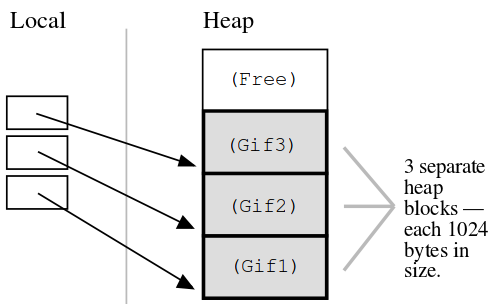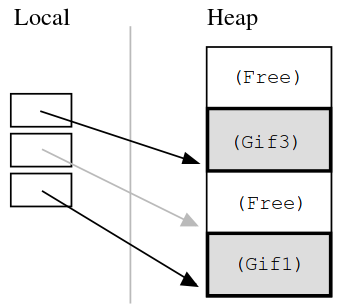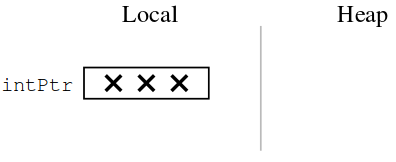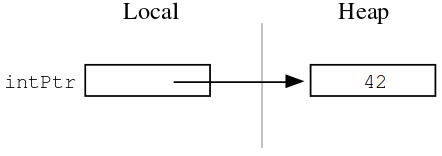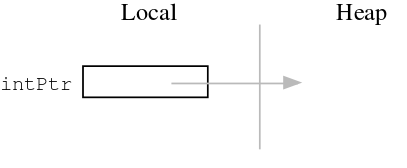5.2. Heap Memory¶
5.2.1. Heap Memory¶
"Heap" memory, also known as "dynamic" memory, is an alternative to local stack memory. Local memory (Section 2) is quite automatic—it is allocated automatically on function call and it is deallocated automatically when a function exits. Heap memory is different in every way. The programmer explicitly requests the allocation of a memory "block" of a particular size, and the block continues to be allocated until the programmer explicitly requests that it be deallocated. Nothing happens automatically. So the programmer has much greater control of memory, but with greater responsibility since the memory must now be actively managed. The advantages of heap memory are:
- Lifetime. Because the programmer now controls exactly when memory is allocated and deallocated, it is possible to build a data structure in memory, and return that data structure to the caller. This was never possible with local memory which was automatically deallocated when the function exited.
- Size. The size of allocated memory can be controlled with more detail. For example, a string buffer can be allocated at run-time which is exactly the right size to hold a particular string. With local memory, the code is more likely to declare a buffer size 1000 and hope for the best. (See the StringCopy() example below.)
The disadvantages of heap memory are:
- More Work. Heap allocation needs to arranged explicitly in the code which is just more work.
- More Bugs. Because it's now done explicitly in the code, realistically on occasion the allocation will be done incorrectly leading to memory bugs. Local memory is constrained, but at least it's never wrong.
Nonetheless, there are many problems that can only be solved with heap memory, so that's that way it has to be. In languages with garbage collectors such as Perl, LISP, or Java, the above disadvantages are mostly eliminated. The garbage collector takes over most of the responsibility for heap management at the cost of a little extra time taken at run-time.
5.2.2. What Does The Heap Look Like?¶
Before seeing the exact details, let's look at a rough example of allocation and deallocation in the heap.
5.2.2.1. Allocation¶
The heap is a large area of memory available for use by the program. The program can request areas, or "blocks", of memory for its use within the heap. In order to allocate a block of some size, the program makes an explicit request by calling the heap allocation function. The allocation function reserves a block of memory of the requested size in the heap and returns a pointer to it. Suppose a program makes three allocation requests to allocate memory to hold three separate GIF images in the heap each of which takes 1024 bytes of memory. After the three allocation requests, memory might look like.
Each allocation request reserves a contiguous area of the requested size in the heap and returns a pointer to that new block to the program. Since each block is always referred to by a pointer, the block always plays the role of a "pointee" (Section 1) and the program always manipulates its heap blocks through pointers. The heap block pointers are sometimes known as "base address" pointers since by convention they point to the base (lowest address byte) of the block. In this example, the three blocks have been allocated contiguously starting at the bottom of the heap, and each block is 1024 bytes in size as requested. In reality, the heap manager can allocate the blocks wherever it wants in the heap so long as the blocks do not overlap and they are at least the requested size. At any particular moment, some areas in the heap have been allocated to the program, and so are "in use". Other areas have yet to be committed and so are "free" and are available to satisfy allocation requests. The heap manager has its own, private data structures to record what areas of the heap are committed to what purpose at any moment The heap manager satisfies each allocation request from the pool of free memory and updates its private data structures to record which areas of the heap are in use.
5.2.2.2. Deallocation¶
When the program is finished using a block of memory, it makes an explicit deallocation request to indicate to the heap manager that the program is now finished with that block. The heap manager updates its private data structures to show that the area of memory occupied by the block is free again and so may be re-used to satisfy future allocation requests. Here's what the heap would look like if the program deallocates the second of the three blocks.
After the deallocation, the pointer continues to point to the now deallocated block. The program must not access the deallocated pointee. This is why the pointer is drawn in gray—the pointer is there, but it must not be used. Sometimes the code will set the pointer to NULL immediately after the deallocation to make explicit the fact that it is no longer valid.
5.2.3. Programming The Heap¶
Programming the heap looks pretty much the same in most languages. The basic features are:
- The heap is an area of memory available to allocate areas ("blocks") of memory for the program.
- There is some "heap manager" library code which manages the heap for
the program. The programmer makes requests to the heap manager,
which in turn manages the internals of the heap. In C, the heap is
managed by the ANSI library functions
malloc(),free(), andrealloc(). - The heap manager uses its own private data structures to keep track of which blocks in the heap are "free" (available for use) and which blocks are currently in use by the program and how large those blocks are. Initially, all of the heap is free.
- The heap may be of a fixed size (the usual conceptualization), or it may appear to be of a fixed but extremely large size backed by virtual memory. In either case, it is possible for the heap to get "full" if all of its memory has been allocated and so it cannot satisfy an allocation request. The allocation function will communicate this run-time condition in some way to the program—usually by returning a NULL pointer or raising a language specific run-time exception.
- The allocation function requests a block in the heap of a particular size. The heap manager selects an area of memory to use to satisfy the request, marks that area as "in use" in its private data structures, and returns a pointer to the heap block. The caller is now free to use that memory by dereferencing the pointer. The block is guaranteed to be reserved for the sole use of the caller—the heap will not hand out that same area of memory to some other caller. The block does not move around inside the heap—its location and size are fixed once it is allocated. Generally, when a block is allocated, its contents are random. The new owner is responsible for setting the memory to something meaningful. Sometimes there is variation on the memory allocation function which sets the block to all zeros (calloc() in C).
- The deallocation function is the opposite of the allocation function. The program makes a single deallocation call to return a block of memory to the heap free area for later re-use. Each block should only be deallocated once. The deallocation function takes as its argument a pointer to a heap block previously furnished by the allocation function. The pointer must be exactly the same pointer returned earlier by the allocation function, not just any pointer into the block. After the deallocation, the program must treat the pointer as bad and not access the deallocated pointee.
5.2.4. C Specifics¶
In the C language, the library functions which make heap requests are
malloc() ("memory allocate") and free().
The prototypes for these functions are in the header file <stdlib.h>.
Although the syntax varies between languages, the roles of
malloc() and free() are nearly identical in all languages.
void* malloc(unsigned long size);Themalloc()function takes an unsigned integer which is the requested size of the block measured in bytes.malloc()returns a pointer to a new heap block if the allocation is successful, and NULL if the request cannot be satisfied because the heap is full. The C operatorsizeof()is a convenient way to compute the size in bytes of a type—sizeof(int)for an int pointee,sizeof(struct fraction)for astruct fractionpointee.
void free(void* heapBlockPointer);Thefree()function takes a pointer t a heap block and returns it to the free pool for later reuse. The pointer passed tofree()must be exactly the pointer returned earlier bymalloc(), not just a pointer to somewhere in the block. Callingfree()with the wrong sort of pointer is famous for the particularly ugly sort of crashing which it causes. The call tofree()does not need to give the size of the heap block—the heap manager will have noted the size in its private data structures. The call tofree()just needs to identify which block to deallocate by its pointer. If a program correctly deallocates all of the memory it allocates, then every call tomalloc()will later be matched by exactly one call tofree(). As a practical matter however, it is not always necessary for a program to deallocate every block it allocates—see "Memory Leaks" below.
5.2.5. Simple Heap Example¶
Here is a simple example which allocates an
int block in the heap, stores the number 42 in the block, and then deallocates it.
This is the simplest possible example of heap block allocation, use, and deallocation.
The example shows the state of memory at three different times during the execution of the above code. The stack and heap are shown
separately in the drawing—a drawing for code which uses stack and heap memory needs
to distinguish between the two areas to be accurate since the rules which govern the two
areas are so different. In this case, the lifetime of the local variable intPtr is totally
separate from the lifetime of the heap block, and the drawing needs to reflect that
difference.
void Heap1() {
int* intPtr;
// Allocates local pointer local variable (but not its pointee)
// T1
// Allocates heap block and stores its pointer in local variable.
// Dereferences the pointer to set the pointee to 42.
intPtr = malloc(sizeof(int));
*intPtr = 42;
// T2
// Deallocates heap block making the pointer bad.
// The programmer must remember not to use the pointer
// after the pointee has been deallocated (this is
// why the pointer is shown in gray).
free(intPtr);
// T3
5.2.6. Simple Heap Observations¶
- After the allocation call allocates the block in the heap. The
program stores the pointer to the block in the local variable
intPtr. The block is the "pointee" andintPtris its pointer as shown at T2. In this state, the pointer may be dereferenced safely to manipulate the pointee. The pointer/pointee rules from Section 1 still apply, the only difference is how the pointee is initially allocated. - At T1 before the call to
malloc(),intPtris uninitialized does not have a pointee—at this pointintPtr"bad" in the same sense as discussed in Section 1. As before, dereferencing such an uninitialized pointer is a common, but catastrophic error. Sometimes this error will crash immediately (lucky). Other times it will just slightly corrupt a random data structure (unlucky). - The call to
free()deallocates the pointee as shown at T3. Dereferencing the pointer after the pointee has been deallocated is an error. Unfortunately, this error will almost never be flagged as an immediate run-time error. 99% of the time the dereference will produce reasonable results 1% of the time the dereference will produce slightly wrong results. Ironically, such a rarely appearing bug is the most difficult type to track down. - When the function exits, its local variable intPtr will be automatically deallocated following the usual rules for local variables (Section 2). So this function has tidy memory behavior—all of the memory it allocates while running (its local variable, its one heap block) is deallocated by the time it exits.
5.2.7. Heap Array¶
In the C language, it's convenient to allocate an array in the heap,
since C can treat any pointer as an array.
The size of the array memory block is the size of each element (as
computed by the sizeof() operator) multiplied by the number of
elements (See CS Education Library/101 The C Language, for a complete
discussion of C, and arrays and pointers in particular).
So the following code heap allocates an array of 100
struct fraction's in the heap, sets them all to 22/7, and
deallocates the heap array.
void HeapArray() {
struct fraction* fracts;
int i;
// allocate the array
fracts = malloc(sizeof(struct fraction) * 100);
// use it like an array -- in this case set them all to 22/7
for (i=0; i<99; i++) {
fracts[i].numerator = 22;
fracts[i].denominator = 7;
}
// Deallocate the whole array
free(fracts);
}
5.2.8. Heap String Example¶
Here is a more useful heap array example. The StringCopy() function takes a C string,
makes a copy of that string in the heap, and returns a pointer to the new string. The caller
takes over ownership of the new string and is responsible for freeing it.
/*
Given a C string, return a heap allocated copy of the string.
Allocate a block in the heap of the appropriate size,
copies the string into the block, and returns a pointer to the block.
The caller takes over ownership of the block and is responsible
for freeing it.
*/
char* StringCopy(const char* string) {
char* newString;
int len;
len = strlen(string) + 1; // +1 to account for the '\0'
newString = malloc(sizeof(char)*len); // elem-size * number-of-elements
assert(newString != NULL); // simplistic error check (a good habit)
strcpy(newString, string); // copy the passed in string to the block
return(newString); // return a ptr to the block
}
5.2.8.1. Heap String Observations¶
StringCopy() takes advantage of both of the key features of heap memory:
- Size.
StringCopy()specifies, at run-time, the exact size of the block needed to store the string in its call tomalloc(). Local memory cannot do that since its size is specified at compile-time. The call tosizeof(char)is not really necessary, since the size ofcharis 1 by definition. In any case, the example demonstrates the correct formula for the size of an array block which iselement-size * number-of-elements. - Lifetime.
StringCopy()allocates the block, but then passes ownership of it to the caller. There is no call to free(), so the block continues to exist even after the function exits. Local memory cannot do that. The caller will need to take care of the deallocation when it is finished with the string.
5.2.9. Memory Leaks¶
What happens if some memory is heap allocated, but never deallocated? A program which forgets to deallocate a block is said to have a memory leak which may or may not be a serious problem. The result will be that the heap gradually fill up as there continue to be allocation requests, but no deallocation requests to return blocks for re-use. For a program which runs, computes something, and exits immediately, memory leaks are not usually a concern. Such a "one shot" program could omit all of its deallocation requests and still mostly work. Memory leaks are more of a problem for a program which runs for an indeterminate amount of time. In that case, the memory leaks can gradually fill the heap until allocation requests cannot be satisfied, and the program stops working or crashes. Many commercial programs have memory leaks, so that when run for long enough, or with large data-sets, they fill their heaps and crash. Often the error detection and avoidance code for the heap-full error condition is not well tested, precisely because the case is rarely encountered with short runs of the program—that's why filling the heap often results in a real crash instead of a polite error message. Most compilers have a "heap debugging" utility which adds debugging code to a program to track every allocation and deallocation. When an allocation has no matching deallocation, that's a leak, and the heap debugger can help you find them.
5.2.10. Ownership¶
StringCopy() allocates the heap block, but it does not deallocate it. This is so the caller
can use the new string. However, this introduces the problem that somebody does need to
remember to deallocate the block, and it is not going to be StringCopy(). That is why the
comment for StringCopy() mentions specifically that the caller is taking on
ownership of the block. Every block of memory has exactly one "owner" who takes responsibility for
deallocating it. Other entities can have pointers, but they are just sharing. There's only
one owner, and the comment for StringCopy() makes it clear that ownership is being
passed from StringCopy() to the caller. Good documentation always remembers to
discuss the ownership rules which a function expects to apply to its parameters or return
value. Or put the other way, a frequent error in documentation is that it forgets to
mention, one way or the other, what the ownership rules are for a parameter or return
value. That's one way that memory errors and leaks are created.
5.2.10.1. Ownership Models¶
The two common patterns for ownership are:
- Caller ownership. The caller owns its own memory. It may pass a pointer to the callee for sharing purposes, but the caller retains ownership. The callee can access things while it runs, and allocate and deallocate its own memory, but it should not disrupt the caller's memory.
- Callee allocated and returned. The callee allocates some memory
and returns it to the caller. This happens because the result of the
callee computation needs new memory to be stored or
represented. The new memory is passed to the caller so they can see
the result, and the caller must take over ownership of the
memory. This is the pattern demonstrated in
StringCopy().
5.2.11. Heap Memory Summary¶
Heap memory provides greater control for the programmer—the blocks of memory can be requested in any size, and they remain allocated until they are deallocated explicitly. Heap memory can be passed back to the caller since it is not deallocated on exit, and it can be used to build linked structures such as linked lists and binary trees. The disadvantage of heap memory is that the program must make explicit allocation and deallocate calls to manage the heap memory. The heap memory does not operate automatically and conveniently the way local memory does.


